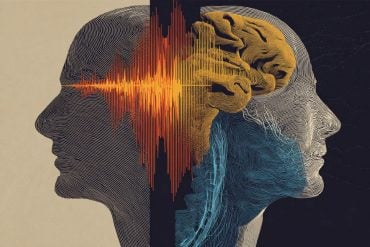Summary: Chronic pain affects one in five adults, and medication alone doesn’t always offer relief. A new review reveals that psychological treatments—particularly cognitive behavioral therapy (CBT)—can reduce pain through measurable changes in the brain.
The review of multiple studies found that therapy shifts brain network activity, helping people loosen harmful thought patterns and reduce emotional stress linked to pain. These brain-based changes are associated with less pain and improved quality of life, offering new hope for accessible, non-drug treatments like CBT or even apps based on it.
Key Facts:
- Brain Changes: Psychological therapy alters brain networks tied to pain and emotion.
- CBT Works: Cognitive behavioral therapy is the most supported and effective method.
- Digital Potential: Apps may offer scalable access to therapy-based pain relief.
Source: Aarhus University
Back pain, migraines, arthritis, long-term concussion symptoms, complications following cancer treatment.
These are just a few of the conditions linked to chronic pain, which affects one in five adults—and for which medication is not always the answer.

Now, a new review study offers insight into how specific types of psychological treatment can help relieve this pain— through physical changes in the brain.
The research article was published today in The Lancet, one of the world’s leading medical journals. The study is led by Professor Lene Vase from the Department of Psychology at Aarhus BSS, Aarhus University.
“Traditionally, people go to the doctor when they are in pain, and the doctor usually prescribes medication to ease the pain. But medication doesn’t always work well for chronic pain, and many doctors are looking for other treatment options.
“Psychological treatment is one alternative, and we are now one step closer to understanding exactly how it works,” says Lene Vase, who in addition to being a professor of psychology also holds a doctorate in medicine.
Scientific explanation
It is not new that psychological treatment can relieve pain. What is new is the detailed scientific explanation behind it.
Many studies have shown that patients experience less pain after psychological treatment. But is this just a feeling? Does the mental processing simply distract us and help us cope with the pain? Or do physical changes in the body actually occur?
In the article published today, Lene Vase and her colleagues review a number of previous studies. Each study on its own is too small and inconclusive to draw firm conclusions about physical changes in patients. However, when the researchers analyse them together, a clear pattern emerges.
“We need more studies before we can pinpoint with scientific certainty exactly which elements of psychological therapy affect the brain, and how.
“However, the analysis we’re publishing today provides clear indications of which specific elements of psychological treatment are most important, and how they are associated with changes in the way the brain and spinal cord process pain,” says Lene Vase.
When the brain is on autopilot
Professor Vase highlights cognitive behavioural therapy (CBT) as a method that shows clear effects. This type of therapy focuses, among other things, on changing automatic thought patterns—the thoughts and feelings that occur when we are not actively thinking, and the brain is on autopilot.
When we are in this state, a specific network in the brain known as the default mode network is active. This network interacts with other brain networks which are directly linked to pain and emotions.
And now, researchers can see—put simply—that activity in these networks changes when people shift their thought patterns and emotions through therapy.
“When you’re in pain, it can easily take over your life. You might worry about how it will affect your job or your family, and you might avoid doing things you used to enjoy. If you are able to loosen these thoughts and emotions and return to living life as normally as possible, we can see that this is linked to visible changes in the brain, less pain and improved quality of life,” says Lene Vase.
Try an app
The professor believes this new knowledge can be used actively by psychologists, doctors and patients.
“So far, what we know most about is the effect of sitting face to face with a psychologist, but unfortunately, there aren’t enough psychologists to treat everyone who suffers from pain.
“Fortunately, it seems that doctors, physiotherapists and nurses can also help guide patients towards pain-relieving ways of thinking. And some people may even be able to help themselves—perhaps by using an app,” says Lene Vase.
There are already more than 500 apps for psychological pain relief, the researchers write in The Lancet. But their effectiveness hasn’t yet been fully documented.
“While we wait for solid scientific evidence, I would personally choose an app based on cognitive behavioural therapy,” says Professor Lene Vase from the Department of Psychology at Aarhus BSS, Aarhus University.
External funding
Independent Research Fund Denmark, Lundbeck Foundation, Aarhus University Research Foundation, National Institutes of Health and the National Institute of Mental Health (USA), Medical Research Council (UK), National Institute for Health and Care Research (UK), The MayDay Foundation, Versus Arthritis, Arthritis Research and Southwood Family Donation
Conflict of interest
Lene Vase has received fees for courses on pain and placebo and has served on the scientific programme committee for the World Congress of Pain. Her two co-authors from the USA and the UK have also received teaching and consulting fees. See the scientific article for more detailed information.
About this pain and psychology research news
Author: Mia Ulvgraven
Source: Aarhus University
Contact: Mia Ulvgraven – Aarhus University
Image: The image is credited to Neuroscience News
Original Research: Closed access.
“Opportunities for chronic pain self-management: core psychological principles and neurobiological underpinnings” by Lene Vase et al. The Lancet
Abstract
Opportunities for chronic pain self-management: core psychological principles and neurobiological underpinnings
One in five of the population lives with chronic pain. Psychological interventions for pain reveal core principles that can be used to create opportunities for chronic pain self-management in primary practice, across health-care settings, and at home.
We highlight the different types of chronic pain and illustrate the psychoneurobiological mechanisms involved.
We review core principles for psychological pain management, evaluate the evidence, and illustrate the underlying neurobiology involved.
We provide practical advice for how to facilitate pain self-management in clinical practice.
Finally, we discuss scientific caveats and practical obstacles to improvement, suggesting possible pathways to implementation.







